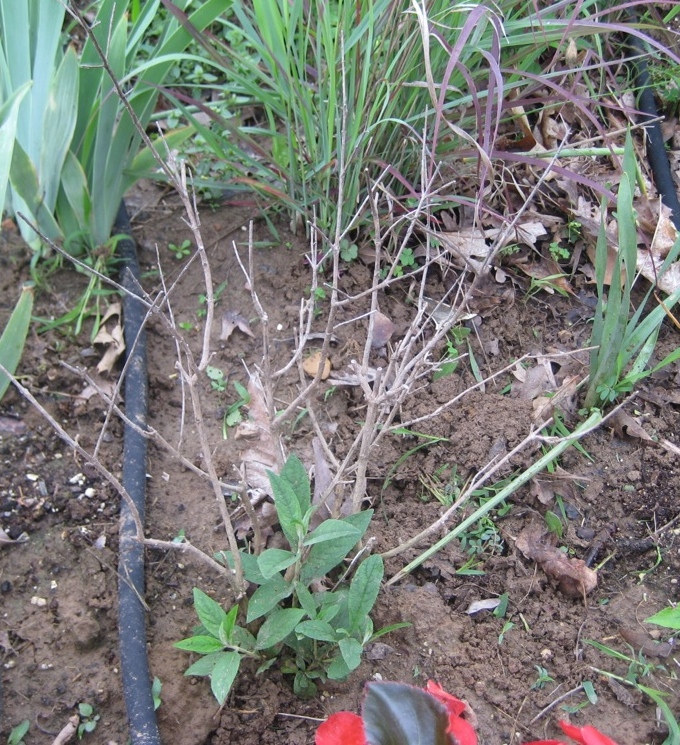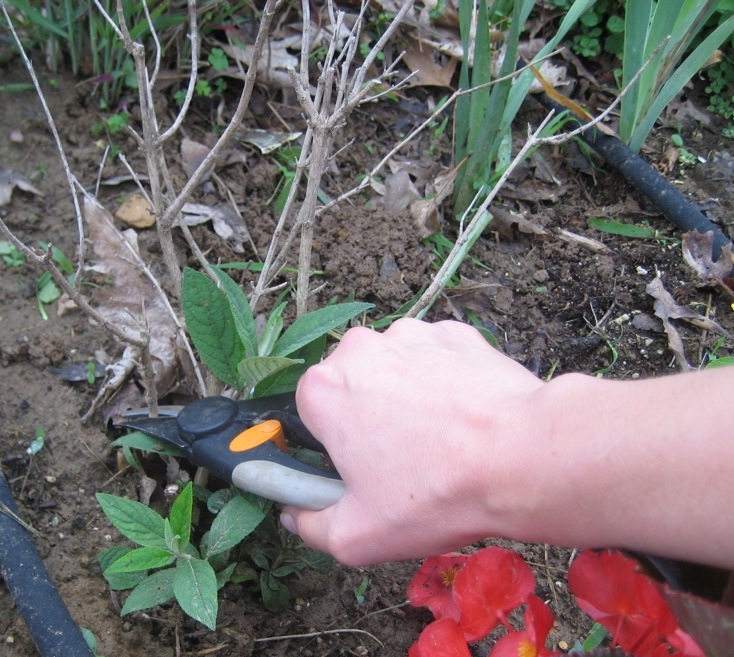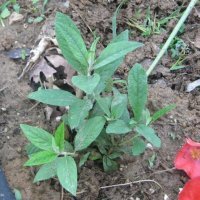Keep Calm and Prune Dead Wood
Learn more about what to do with shrubs damaged in winter.
 Winter is the last thing anyone wants to think about now, but for many of us, the condition of our gardens simply won’t let us forget. Extremely cold temperatures, coupled with strong winds and soil that was frozen solid for months, combined to cause some serious damage to shrubs that had sailed through previous winters. You’ve probably seen a lot of brown leaves and stems on broad-leaf evergreens like boxwood, holly, and rhododendron, but deciduous flowering shrubs like butterfly bush, caryopteris, and big-leaf hydrangea also suffered pretty badly in much of North America. Even hardy landscape roses, which usually come through winter unscathed, were knocked back severely in many people’s gardens due to winter shrub damage recovery challenges.
Winter is the last thing anyone wants to think about now, but for many of us, the condition of our gardens simply won’t let us forget. Extremely cold temperatures, coupled with strong winds and soil that was frozen solid for months, combined to cause some serious damage to shrubs that had sailed through previous winters. You’ve probably seen a lot of brown leaves and stems on broad-leaf evergreens like boxwood, holly, and rhododendron, but deciduous flowering shrubs like butterfly bush, caryopteris, and big-leaf hydrangea also suffered pretty badly in much of North America. Even hardy landscape roses, which usually come through winter unscathed, were knocked back severely in many people’s gardens due to winter shrub damage recovery challenges.
Though a wait-and-see approach is our advice for spring, once you’re on the cusp of summer, the time for action has arrived. The bad news: if a plant or part of a plant isn’t showing any signs of life by early summer, it probably didn’t make it through the winter. The good news, though, is that you can now safely prune dead wood shrubs and get your garden back on the track to health and beauty. Here’s what to do:
 For shrubs that suffered die back – that is, there’s growth coming in on some part of the plant, but not all of it - cut off the dead stems to just above some vigorous new growth. Don’t be afraid to remove small, spindly growth if there are bigger, healthier buds growing below. Shrub pruning after winter will allow more sunshine to the rest of the plant and neatens the appearance considerably. If a branch died back completely, do your best to trace it back to the main part of the shrub and remove it with pruners. On some plants, especially boxwood, this may mean taking out quite a bit of the plant, but don’t worry: the plant is definitely better without it.
For shrubs that suffered die back – that is, there’s growth coming in on some part of the plant, but not all of it - cut off the dead stems to just above some vigorous new growth. Don’t be afraid to remove small, spindly growth if there are bigger, healthier buds growing below. Shrub pruning after winter will allow more sunshine to the rest of the plant and neatens the appearance considerably. If a branch died back completely, do your best to trace it back to the main part of the shrub and remove it with pruners. On some plants, especially boxwood, this may mean taking out quite a bit of the plant, but don’t worry: the plant is definitely better without it.
Once you’ve pruned the dead wood shrubs off the plant, take a good hard look at what’s left. Has it been damaged so badly that it is no longer contributing to your landscape? If so, you should consider replacing it. You can transplant it to a less conspicuous part of your yard while it recovers in hopes of using it again, but you deserve better than to spend the entire season looking at a less-than-beautiful shrub. If, on the other hand, the plant is still in pretty good shape, commit yourself to taking extra-good care of it this season. Give it a light application of granular fertilizer formulated for woody plants (I like rose fertilizer for flowering shrubs, holly fertilizer for foliage plants) and keep it well watered all summer to encourage a rapid winter shrub damage recovery.
 We don’t have a crystal ball to tell us what to expect in winter, but we can share three tips to give your shrubs the best chance for long-term survival. One, grow plants that are hardy in your zone. Your hardiness zone is based on the lowest minimum temperature recorded in your area, so if you live in zone 5, a plant sold as hardy to zone 5 should be able to survive. Know your zone and shop for plants with it in mind. If you really want to play it safe, choose plants that are a zone hardier (i.e., a lower number) than your zone. Two, be very careful with fertilizer. Applying fertilizer to woody plants after mid-late July in cold climates pushes soft new growth that is readily damaged by the cold temperatures coming in autumn. Some plants, like butterfly bush and azalea, are especially sensitive to late season nutrient boosts, so it’s a good rule to avoid fertilizing trees, shrubs, and perennials after mid-summer. Finally, keep your plants happy. Proper shrub pruning after winter and siting them appropriately with regard to their preferences for sun, well-drained soil, and space. Plants with well-established, healthy root systems are much better able to withstand weather-related stress than those that are struggling in less-than-ideal conditions.
We don’t have a crystal ball to tell us what to expect in winter, but we can share three tips to give your shrubs the best chance for long-term survival. One, grow plants that are hardy in your zone. Your hardiness zone is based on the lowest minimum temperature recorded in your area, so if you live in zone 5, a plant sold as hardy to zone 5 should be able to survive. Know your zone and shop for plants with it in mind. If you really want to play it safe, choose plants that are a zone hardier (i.e., a lower number) than your zone. Two, be very careful with fertilizer. Applying fertilizer to woody plants after mid-late July in cold climates pushes soft new growth that is readily damaged by the cold temperatures coming in autumn. Some plants, like butterfly bush and azalea, are especially sensitive to late season nutrient boosts, so it’s a good rule to avoid fertilizing trees, shrubs, and perennials after mid-summer. Finally, keep your plants happy. Proper shrub pruning after winter and siting them appropriately with regard to their preferences for sun, well-drained soil, and space. Plants with well-established, healthy root systems are much better able to withstand weather-related stress than those that are struggling in less-than-ideal conditions.
Take a look at our Gardening Simplified reference guide to pick the best shrubs for your landscape!




